Abstract
Berry, G., McKerrow, C. B., Molyneux, M. K. B., Rossiter, C. E., and Tombleson, J. B. L. (1973).Brit. J. industr. Med.,30, 25-36. A study of the acute and chronic changes in ventilatory capacity of workers in Lancashire cotton mills. A prospective study of workers in 14 cotton and two man-made fibre spinning mills in Lancashire was carried out over a three-year period. A questionnaire on respiratory symptoms was completed at the start of the survey and again two years later. Up to six measurements of ventilatory capacity were made at six-monthly intervals. From these measurements the rate at which the forced expiratory volume (FEV1) was declining (annual decline in FEV) was evaluated for 595 subjects. Six of the mills were visited on Mondays and in 199 operatives the ventilatory capacity was measured at both the beginning and end of the shift to evaluate its acute fall during work (Monday fall in FEV).
The mean annual decline in FEV for cotton workers was 54 ml/year and it was only 32 ml/year for workers in the man-made fibre mills but this lower value was attributable almost entirely to one of the two mills. For the jobs near the carding engines the annual decline was 22 ml/year higher than for speed-frame tenters. The annual decline for cigarette smokers was 19 ml/year greater than for non- and ex-smokers. The annual decline in FEV was not found to be related to symptoms of byssinosis or bronchitis, nor to present dust levels, bioactivity of the dust or air pollution, although the expected effect attributable to byssinosis turned out to be less than that which the survey was designed to detect.
The mean Monday fall in FEV was higher in cotton mills than in man-made fibre mills among those without symptoms of byssinosis and was correlated with present dust levels. For those with symptoms of byssinosis an increased Monday fall was found only in those processing coarse cotton.
For those subjects who completed the respiratory questionnaire on two occasions the chronic and acute changes in FEV were examined in relation to the change in symptoms of byssinosis. No association was found for annual decline in FEV but the Monday fall in FEV was greater for those who developed byssinosis during the survey than for those who remained free of symptoms, and was less for those who lost their symptoms than for those who retained them.
Full text
PDF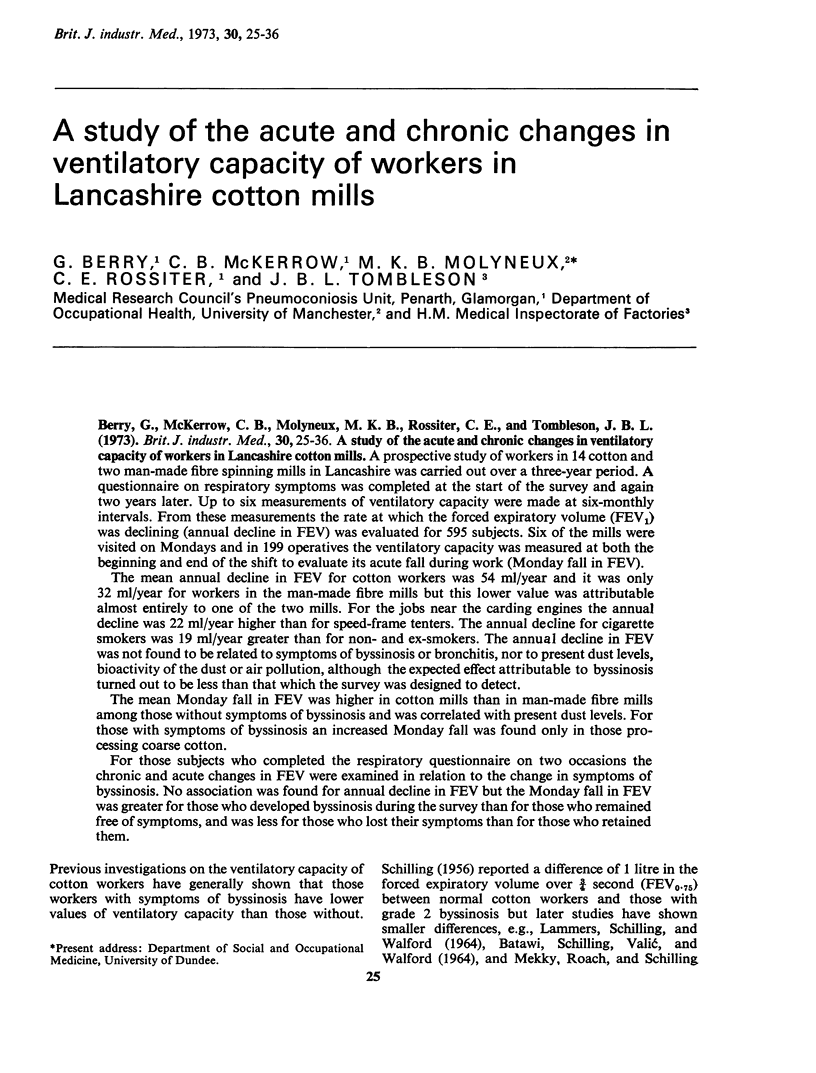
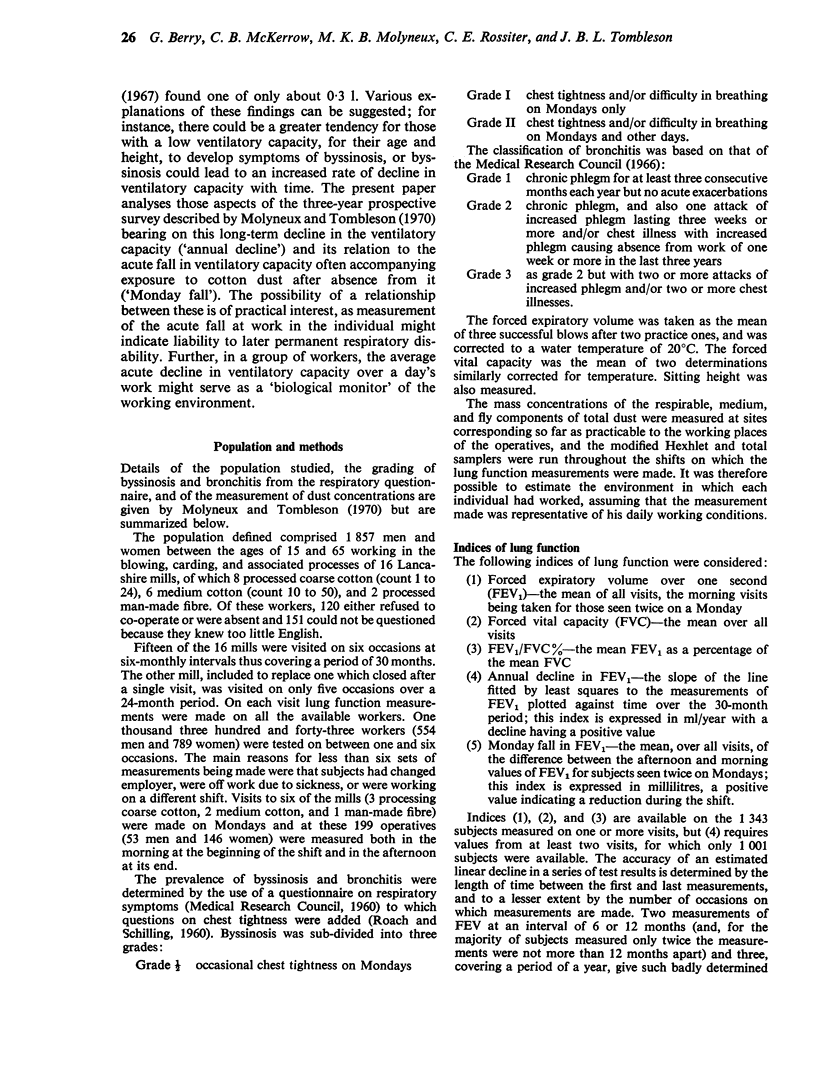
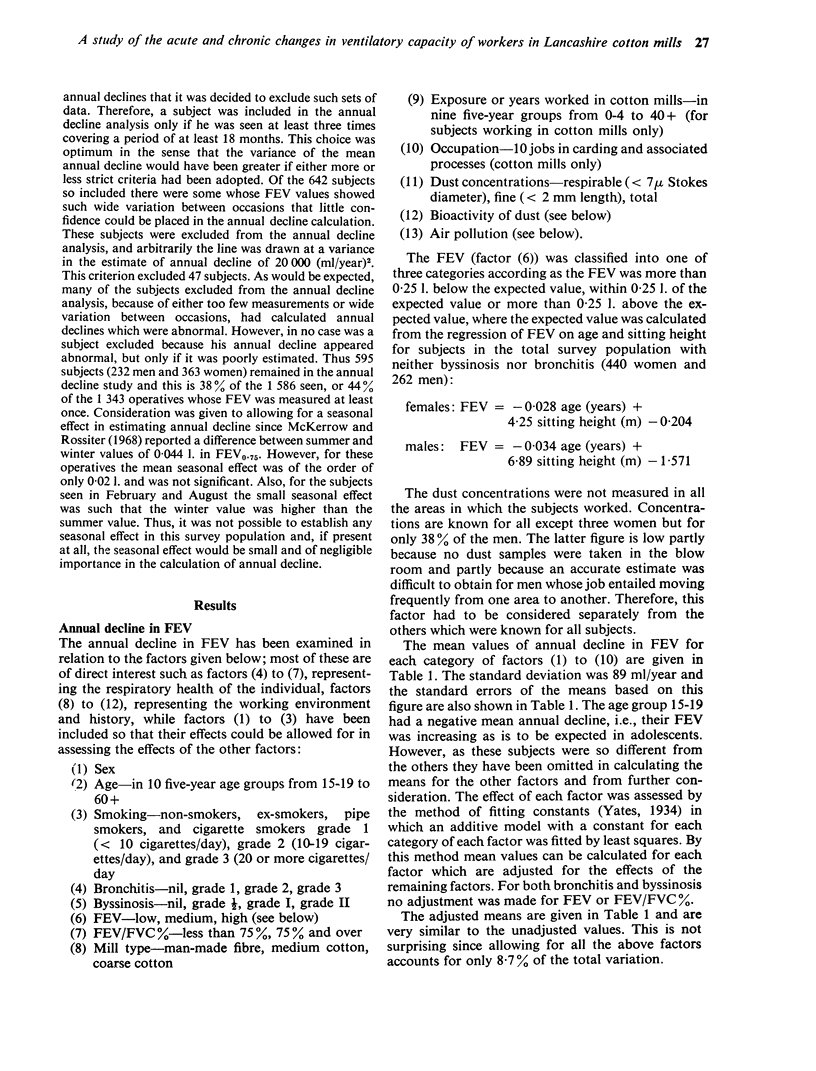
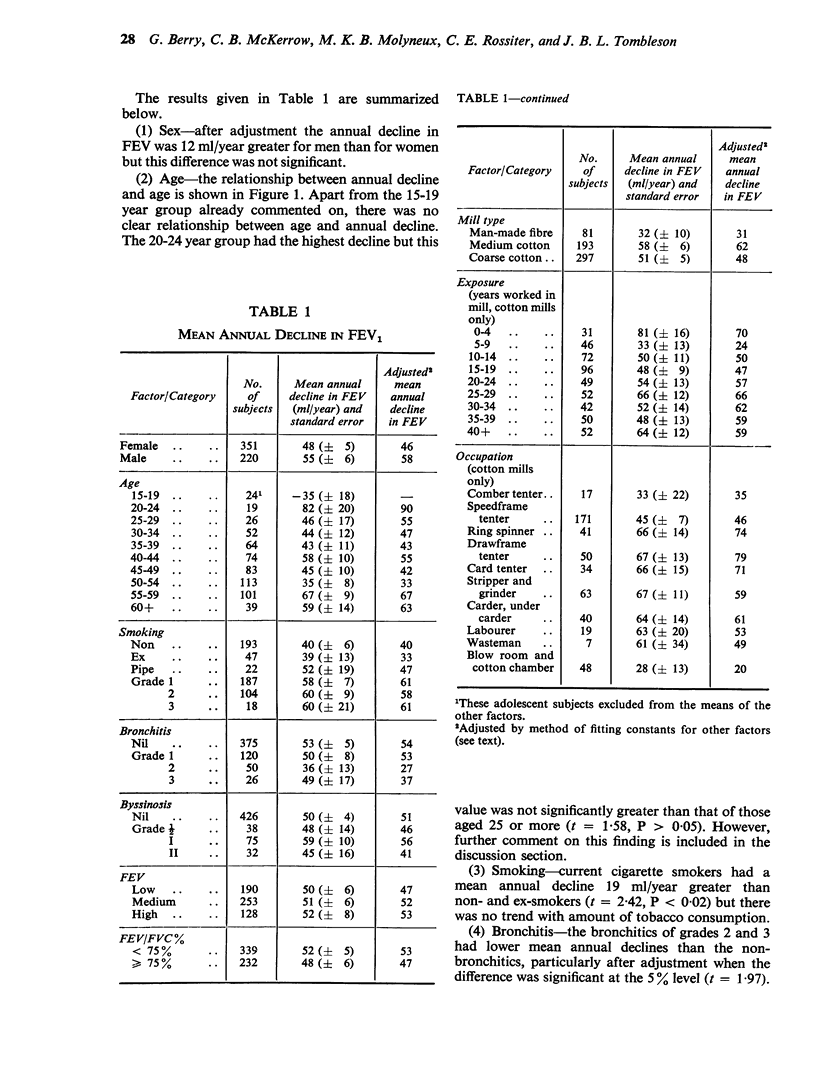
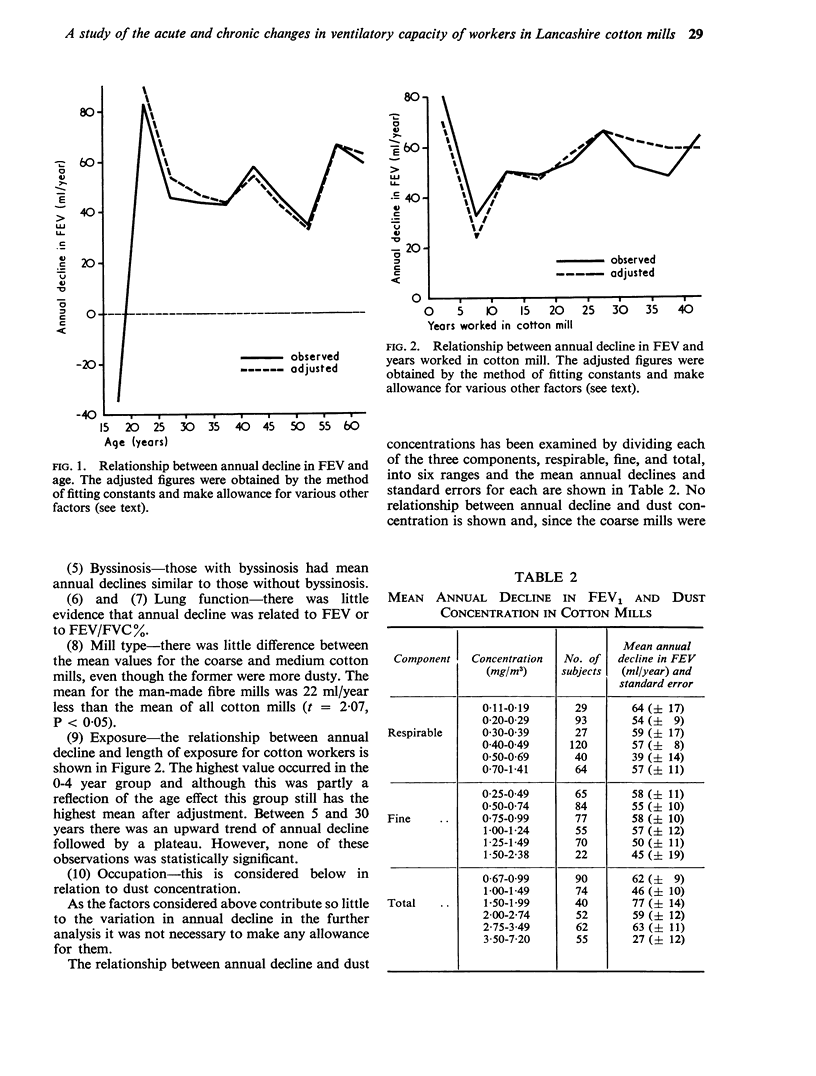
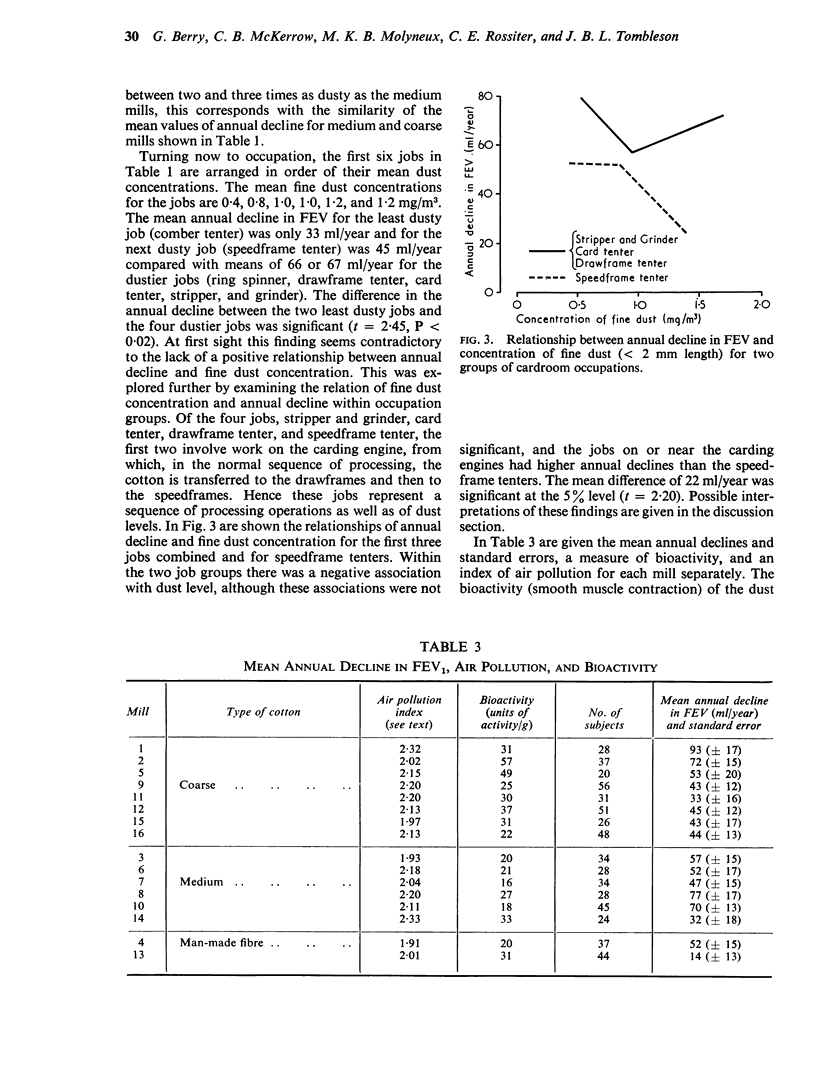
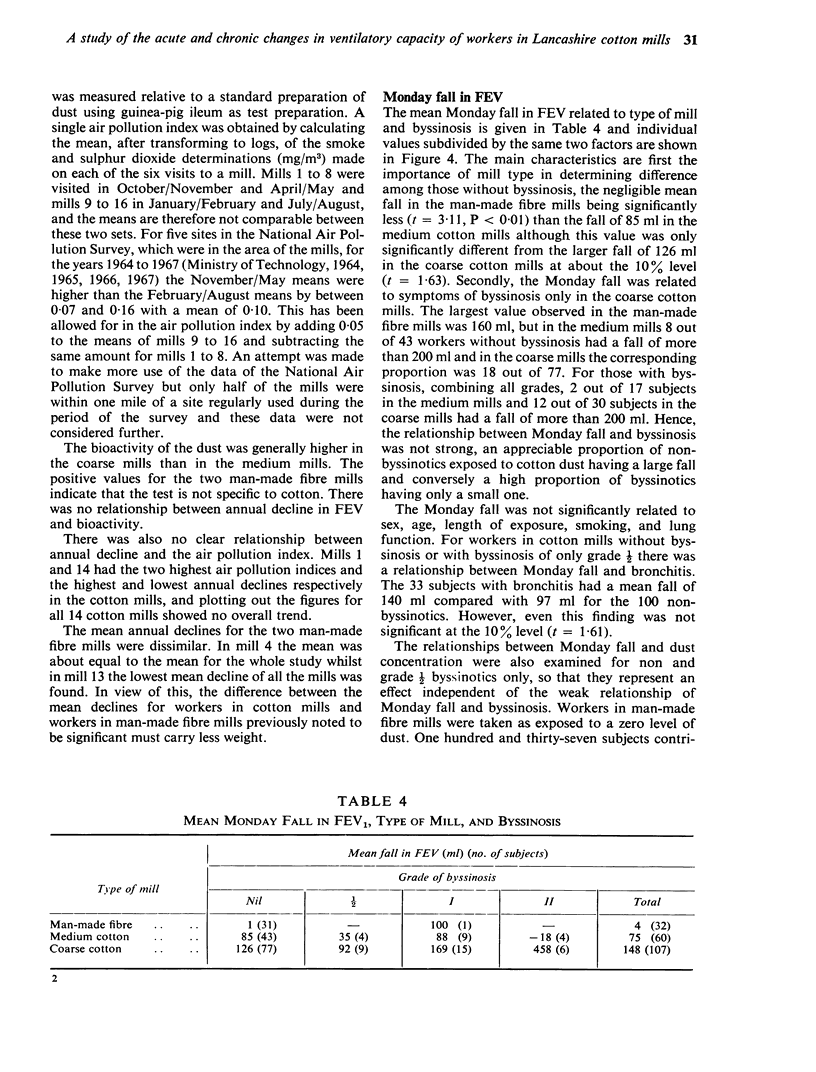
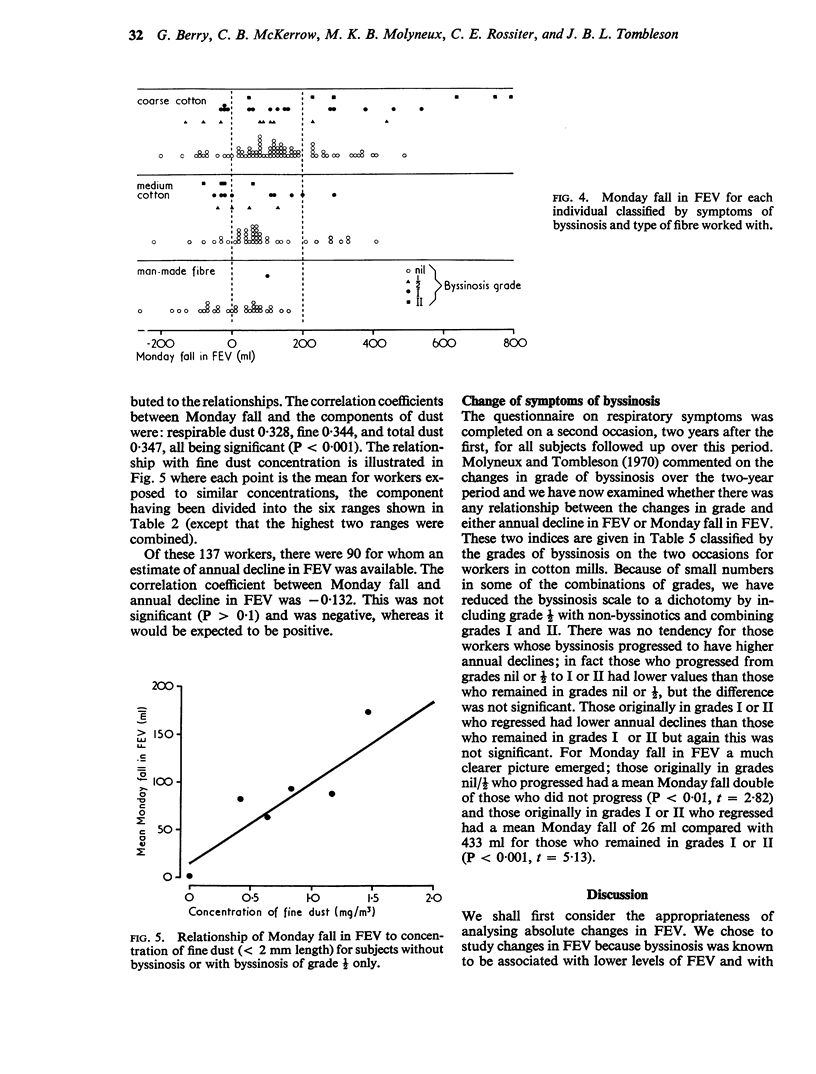
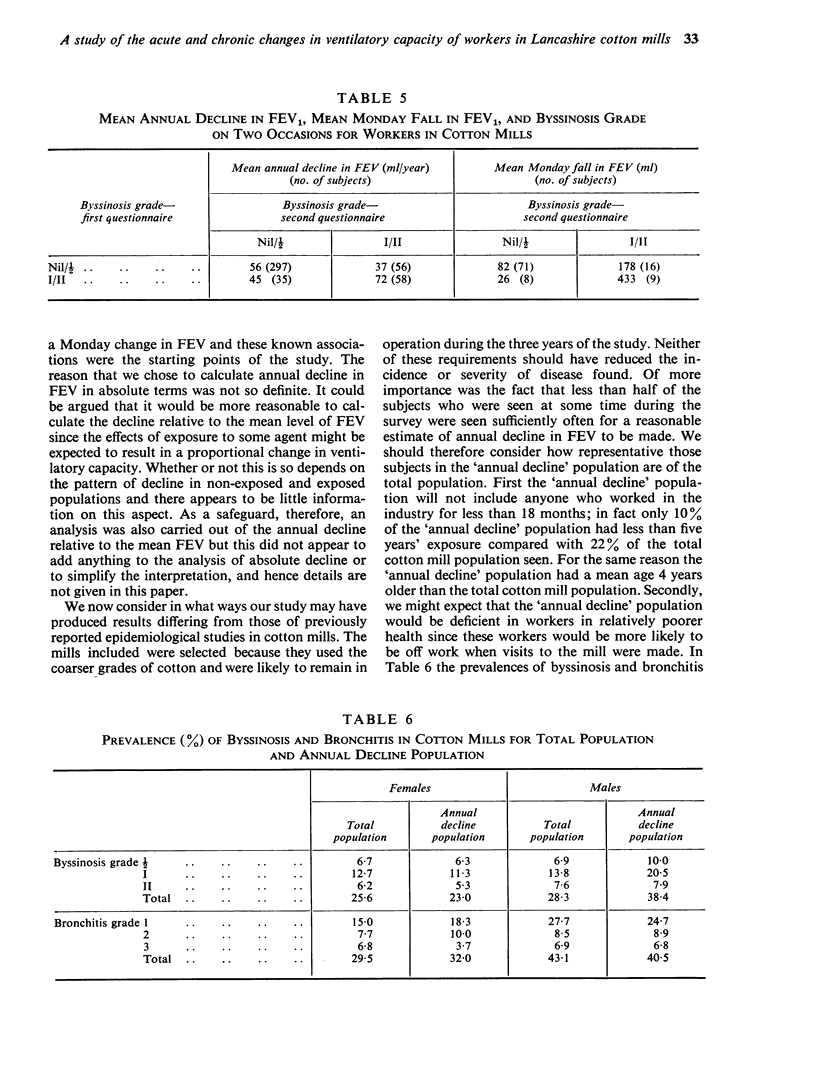
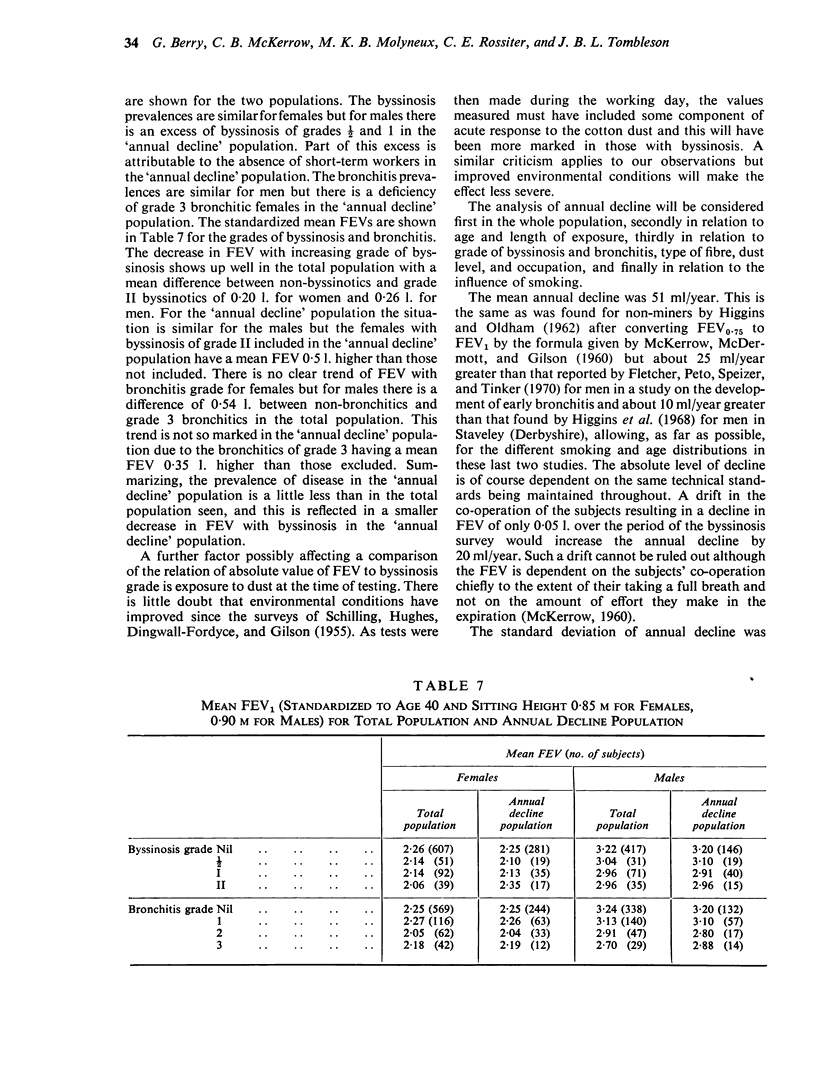
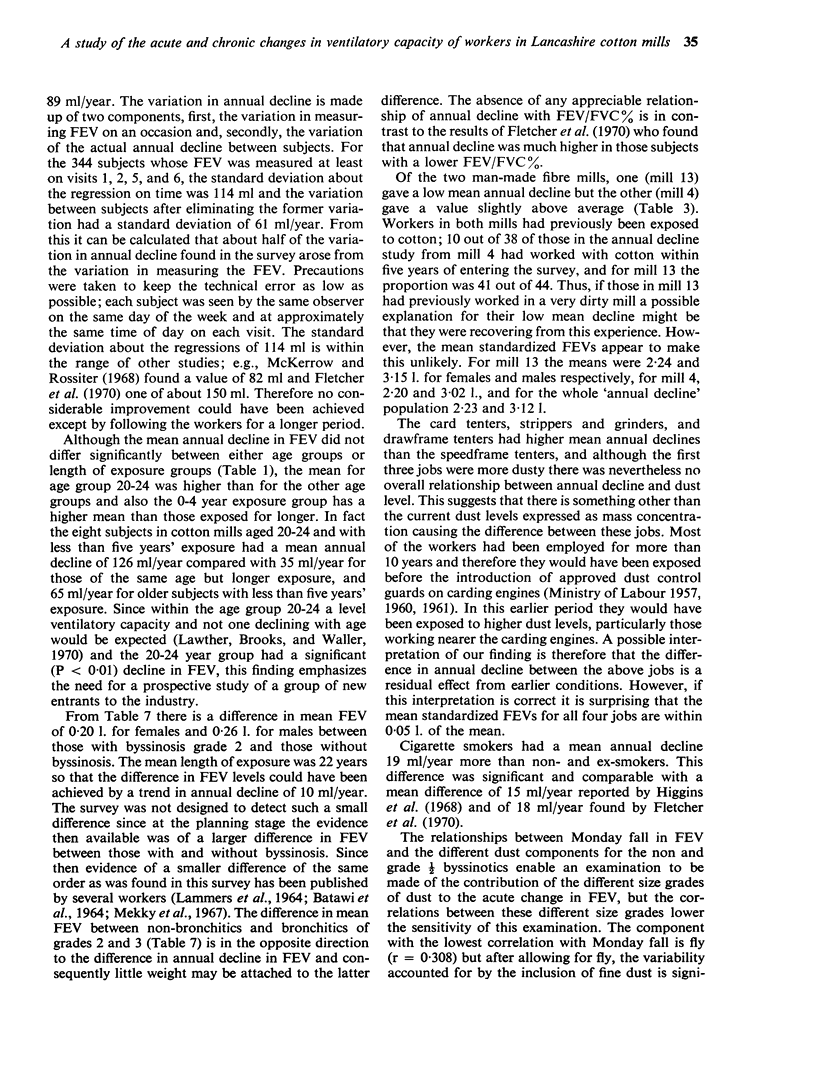
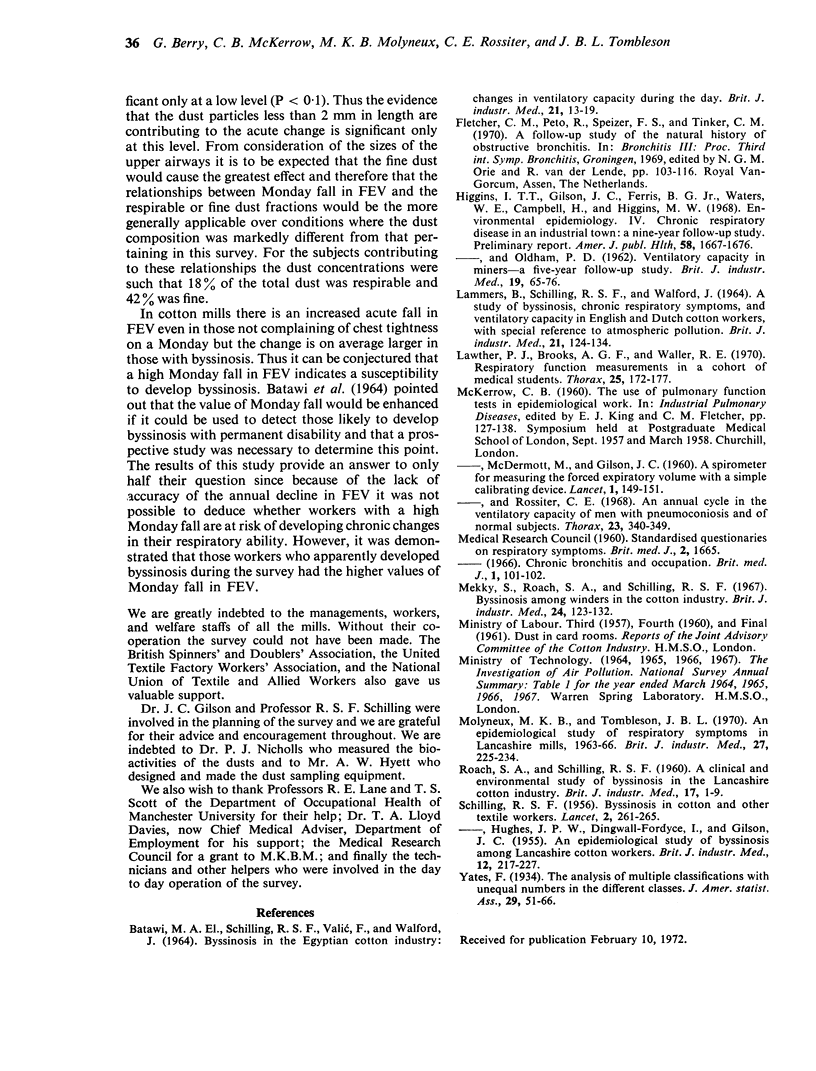
Selected References
These references are in PubMed. This may not be the complete list of references from this article.
- ELBATAWI M. A., SCHILLING R. S., VALIC F., WALFORD J. BYSSINOSIS IN THE EGYPTIAN COTTON INDUSTRY: CHANGES IN VENTILATORY CAPACITY DURING THE DAY. Br J Ind Med. 1964 Jan;21:13–19. doi: 10.1136/oem.21.1.13. [DOI] [PMC free article] [PubMed] [Google Scholar]
- HIGGINS I. T., OLDHAM P. D. Ventilatory capacity in miners. A five-year follow-up study. Br J Ind Med. 1962 Jan;19:65–76. doi: 10.1136/oem.19.1.65. [DOI] [PMC free article] [PubMed] [Google Scholar]
- Higgins I. T., Gilson J. C., Ferris B. G., Jr, Waters M. E., Campbell H., Higgins M. W. Environmental epidemiology. IV. Chronic respiratory disease in an industrial town: a nine-year follow-up study. Preliminary report. Am J Public Health Nations Health. 1968 Sep;58(9):1667–1676. doi: 10.2105/ajph.58.9.1667. [DOI] [PMC free article] [PubMed] [Google Scholar]
- LAMMERS B., SCHILLING R. S., WALFORD J., MEADOWS S., ROACH S. A., VAN DEN HOVEN D., VAN DEN VEEN Y. G., WOOD C. H. A STUDY OF BYSSINOSIS, CHRONIC RESPIRATORY SYMPTOMS, AND VENTILATORY CAPACITY IN ENGLISH AND DUTCH COTTON WORKERS, WITH SPECIAL REFERENCE TO ATMOSPHERIC POLLUTION. Br J Ind Med. 1964 Apr;21:124–134. doi: 10.1136/oem.21.2.124. [DOI] [PMC free article] [PubMed] [Google Scholar]
- Lawther P. J., Brooks A. G., Waller R. E. Respiratory function measurements in a cohort of medical students. Thorax. 1970 Mar;25(2):172–177. doi: 10.1136/thx.25.2.172. [DOI] [PMC free article] [PubMed] [Google Scholar]
- McKerrow C. B., Rossiter C. E. An annual cycle in the ventilatory capacity of men with pneumoconiosis and of normal subjects. Thorax. 1968 Jul;23(4):340–349. doi: 10.1136/thx.23.4.340. [DOI] [PMC free article] [PubMed] [Google Scholar]
- Mekky S., Roach S. A., Schilling R. S. Byssinosis among winders in the cotton industry. Br J Ind Med. 1967 Apr;24(2):123–132. doi: 10.1136/oem.24.2.123. [DOI] [PMC free article] [PubMed] [Google Scholar]
- Molyneux M. K., Tombleson J. B. An epidemiological study of respiratory symptoms in Lancashire mills, 1963-66. Br J Ind Med. 1970 Jul;27(3):225–234. doi: 10.1136/oem.27.3.225. [DOI] [PMC free article] [PubMed] [Google Scholar]
- ROACH S. A., SCHILLING R. S. A clinical and environmental study of byssinosis in the Lancashire cotton industry. Br J Ind Med. 1960 Jan;17:1–9. doi: 10.1136/oem.17.1.1. [DOI] [PMC free article] [PubMed] [Google Scholar]
- SCHILLING R. S. Byssinosis in cotton and other textile workers. Lancet. 1956 Aug 11;271(6937):261–contd. doi: 10.1016/s0140-6736(56)92077-3. [DOI] [PubMed] [Google Scholar]
- SCHILLING R. S., HUGHES J. P., DINGWALL-FORDYCE I., GILSON J. C. An epidemiological study of byssinosis among Lancashire cotton workers. Br J Ind Med. 1955 Jul;12(3):217–227. doi: 10.1136/oem.12.3.217. [DOI] [PMC free article] [PubMed] [Google Scholar]


